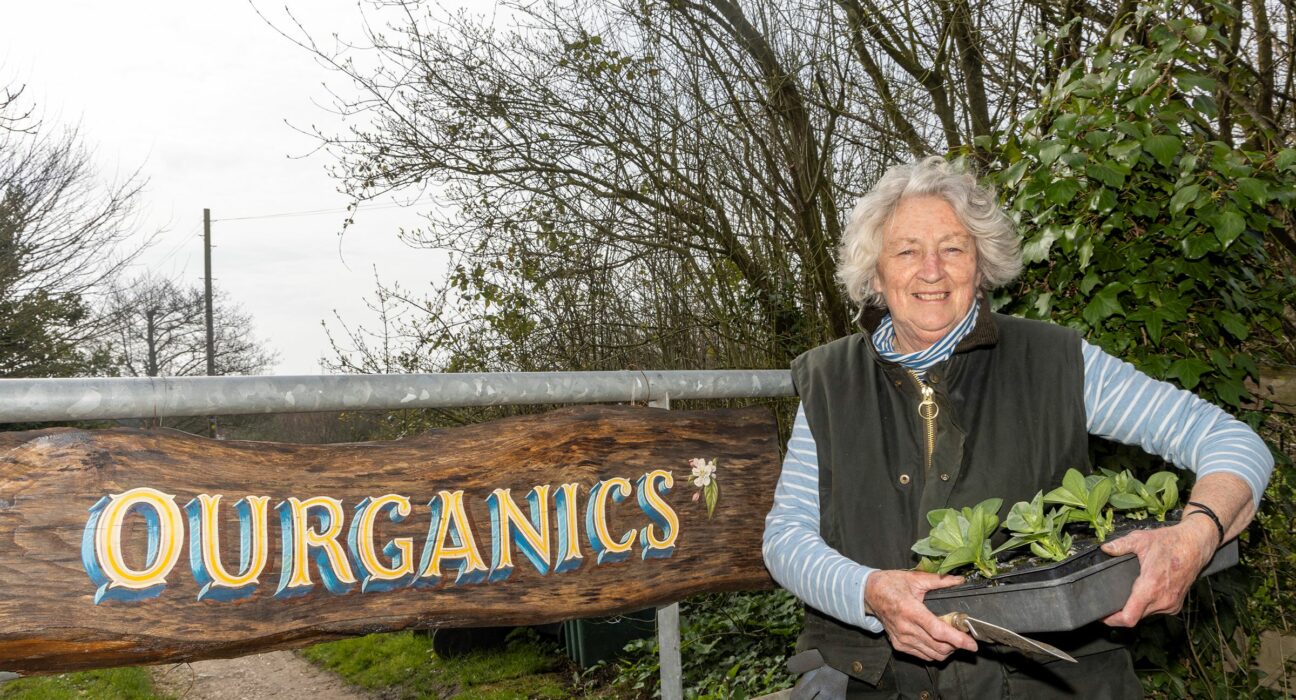For Pat Bowcock, 70, one of her greatest thrills has been the acquisition of a shiny new twin tub which runs off her solar panels and wind turbine. This is a big win.
Pat, a former dispensing receptionist, arrived on the five-acre site in Litton Cheney 21 years ago, having become drawn to the ethics of permaculture.
Aged 48, having brought up two children and recently divorced, she was looking for a different way of life – one that wouldn’t cost the earth both figuratively and literally.
It wasn’t a widespread ideal back then, this low-impact lifestyle. But in recent years we’ve all had to consider ways to reduce our imprint on the planet and Pat is light years ahead of the curve, having lived off grid since June 3, 1999.
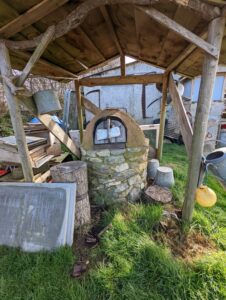
“I was idealistic about how it would be,” she said. “I hadn’t really grown much in the past and I hadn’t built a shelter since I was seven.
“But I drew up a permaculture design in those first three months on the site. I didn’t miss anything about my old life at first. It was so quiet, such a relief.
“People come here and they also fall in love with it. They are idealistic about it too. Of course it’s wonderful, incredible. But running any business isn’t without stress.
“I’ve learned patience and trust. Things get done.”
Pat had taken courses in permaculture, including one at Kingston Maurward, and was on the lookout for land in Ireland when the site, which she has called Ourganics, came on the market, as a pony paddock.
“It’s just under five acres of ancient watermeadow,” she said. “There’s a high water table and clay, very good for growing but no good for animals.
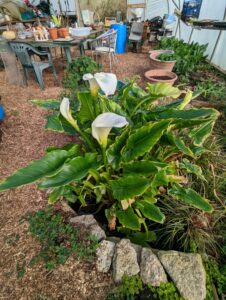
“I decided to buy it as my parents were getting older and I wanted to be here for them. I still go back to Ireland whenever I can because I love it there. The air is very light.”
At first, Pat lived in an old caravan while she established her market garden and dug channels for the water to feed the site. “That’s the only time I’ve had major equipment up here. For the most part I rely on sharing equipment, so I welcome people with a strimmer, for example.
“I use someone else’s apple press to make my apple juice. There’s no point us all having these things if we can utilise the sharing economy.”
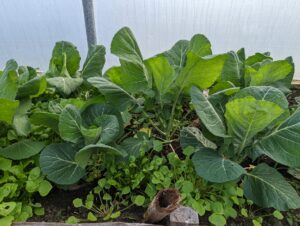
Once the groundwork was done, Pat set about building her home, affectionately known as The Shed.
“We called it The Shed, after someone said, ‘What a lovely shed’ when it was first built,” she smiled. The Shed is a gorgeous, cosy space with a kitchen, living area and bedroom with lovely handmade patchwork quilts, a woodburner and a few electricals, running off solar and wind power stored in batteries outside.
It’s comfortable, clean and welcoming. But it’s taken time to establish and there was a time when Pat started to miss small parts of the life she had left behind.
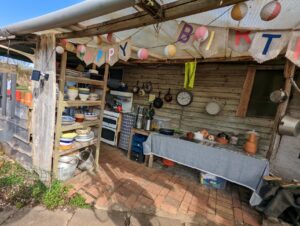
She said: “I began to miss certain things, such as hot running water, a washing machine and a fridge and freezer. I’m only missing the freezer now, as I’ve got all the others.”
The River Bride flows along the bottom of the site, past a little area people call ‘the beach’, perfect for paddling. A stream fed by a spring in the village flows into the top of the site and along a channel with little sluice gates to control the water table.
Water is pumped from a well, filtered and boiled. Pat said: “It would have been astronomically expensive to connect to the mains water system. So I came up with another way.”
There’s always another way. And there are always people willing to help. Many people come here to help out as volunteers, or attend one of Pat’s courses in permaculture. It’s a stunning site, created over years of hard work, with many surprising features tucked away in its various areas.
“I’m very, very grateful for what I have,” said Pat. “I feel deeply privileged. What we see today is the result of a lot of hard work by many people and I’m very grateful to them all. I’m especially grateful to my parents, who embraced my way of life wholeheartedly. They were absolutely fantastic, supporting me when they sometimes didn’t really understand what I was doing.”
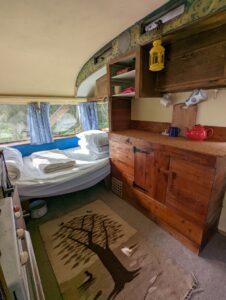
Pat is accompanied everywhere by Sam, a nine-year-old lab-collie cross.
She said: “Sam is my right-hand man. He looks after the chickens, keeps the fox away and lets me know when people are coming. He’s a delight – always ready to play, but he’s a great worker.”
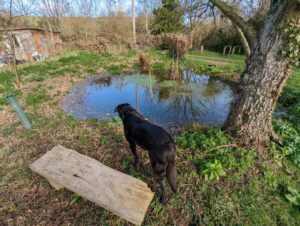
“He makes sure the chickens don’t go where they shouldn’t. “Occasionally he’ll let me have a rabbit he’s caught, though not always. He loves people. During lockdown he sat at the gate for a month, wondering where everyone had gone.”
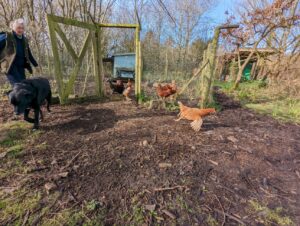
There is a mixed flock of chickens here, who provide eggs to eat and to sell, and many top bar hives for the bees.
This year Pat also hopes to keep some of the bees in trees and baskets.
Veg and flowers grow in abundance in the 27-metre polytunnel and fruit on the trees in the orchard area, which surrounds a dewpond.
Pat mainly eats seasonal produce, with the odd illicit chunk of chocolate or glass of wine.
She sometimes swaps her produce for local meat, and sometimes buys it. Swapping and bartering is a big part of this low-impact life.
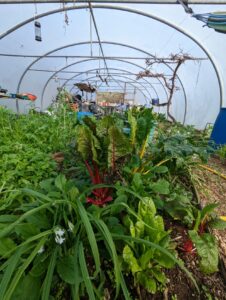
Pat said: “I wanted to live off-grid because I wanted to lower my imprint on the planet, take fewer of its resources.
“It’s something we can all do if we just use less.
“Having bought this land I decided to live off what the land gave me. I aim to be an ethical eater.”
Even in the depths of winter she works the land, growing food.
“I really love the winter,” she said. “It has a beauty of its own. I grow seasonal veg flowers and fruit and bottle the fruit to eat in winter. I have grown melons in the polytunnel. It’s mostly salad in here, with a lot of seeds growing on shelves.”
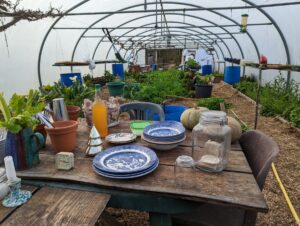
Pat uses the produce to not only feed herself and people who come to help and come to stay. She also sells all she produces – the honey, the eggs and the flowers too.
She said: “There are a few things I have to buy, such as fuel for the car, rice, chocolate and wine, though I have made wine from rhubarb and apple – it was revolting!
“I eat what I grow and buy locally.
“I wasn’t going to do animals, as it gets so muddy here, the clay sticks in their feet. Even donkeys can’t handle clay.”
A woodland at the bottom provides plenty of willow to sell and the polytunnel acts as a dining room, sitting room and meeting room, and a venue for a sewing group Pat’s involved in. It’s a very useful space – and houses the shower, twin tub and more.
The site has been used for weddings and there’s an area of open space where guests can camp, as well as the caravans dotted about the site.
It’s a chance for others to experience the life Pat craved all those years ago and which still brings her so much happiness. It’s still a quiet life. But one which she welcomes guests into with open arms and good coffee.
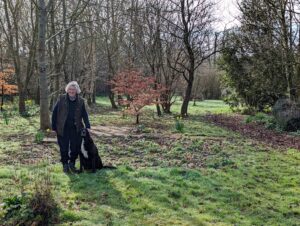
“I don’t think about the future, I just get on with everyday life,” said Pat. “It’s as stressful as I allow it to be. Everything always gets done.”
n Pat offers tours and visits to groups including schools, clubs and individuals, and courses in permaculture. Call 01308 482455 to book.
A two-week course is being held at Ourganics from July 16-30, costing from £465 to £855. The course includes 90 hours of tuition in how to design a low-impact lifestyle, encompassing your home, garden and livelihood. Fees include food, tuition and resources. Residential and non-residential places available.
learnpermaculture.com, call 01503 240946 or email aranya@ learnpermaculture.com




